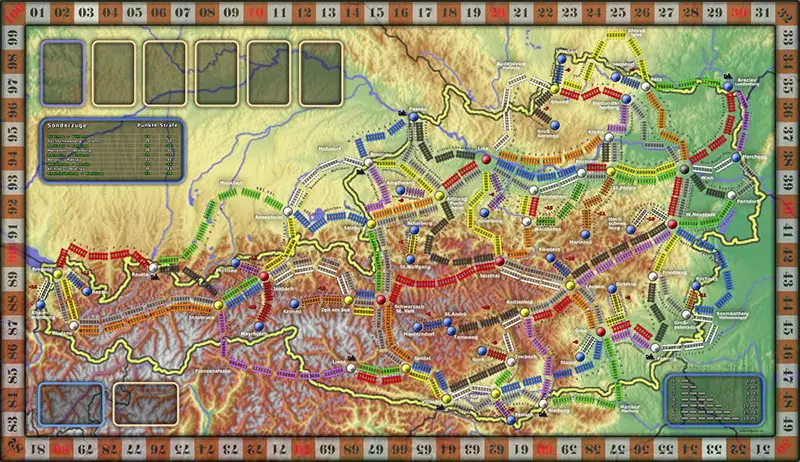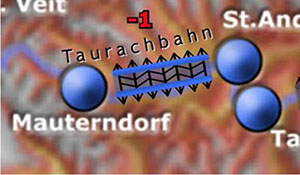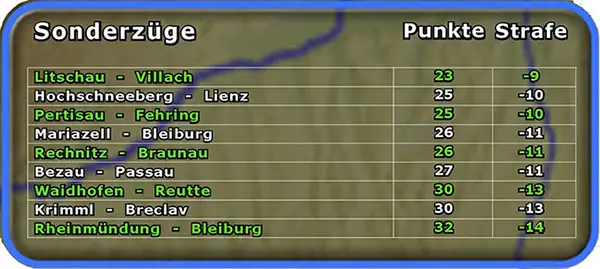
Designed by Bodo Malo. English translation by Ute Tabi and Timur Tabi.
Use the base rules from the U.S. edition. If preferred, the train stations of the Europe edition may be used; playing with the passengers and goods from the Germany edition is also possible.
There are 56 destination cards, which is a bit more than in the original game. Therefore, drawing more Destination Cards to facilitate the game is recommended.
Take six cards at the beginning of the game and keep at least three. Take four cards during the game and keep at least one. Discarded cards should be placed at the bottom of the deck.
Some optional, but recommended, rules:
- Award 10 victory points for the longest continuous track.
- Award 10 victory points to each player who establishes a continuous West-to-East path. That is, from Bregenz or Bludenz to either Breclav, Marchegg, Parndorg, Großpetersdorf, or Fehring.
The following special rules apply:
There are specially marked Tourist Routes with zig-zag tracks. Each route is named and connects to at least one terminal station. A negative point score in red appears next to the name.

These tracks are built like tunnels, following the rules for tunnel construction in the Europe edition.
If a player builds on one of these special tracks and cannot complete the Destination Ticket or does not even have the Destination Ticket, he will lose points at the end of the game.
The corresponding points are marked in red on the game board. For example, minus eight points if a player builds the Feistritztalbahn, but cannot complete the rest of the Birkfeld - Pöchlarn Destination Ticket, or does not even have that Destination Ticket, by the end of the game.
The nine longest of these Tourist Paths ("Sonderzüge") are listed separately on the game board. The reason for this is that a player might employ a targeted tactic to prevent opponents from completing these paths.

"Punkte" are the points you get if you have the corresponding Destination Ticket and complete the path on that ticket. "Strafe" are the points you lose if you build on that path's Tourist Route but do not have or did not complete its Destination Ticket.
The fact is, these nine paths are overvalued. For example, the Rheinmündung - Bleiburg path scores 32 victory points, when normally it would be worth only 24 points.
Thus, it could be of a tactical advantage to observe the other players closely to find out which tracks they are building in order to prevent their completion at the last minute. This can be done via two methods:
-
Build the special track yourself and lose 14 points. In return, your opponent loses the full 32 points for being unable to complete the track.
-
If your opponent builds the special track too early, that signals that now it is important to prevent him from reaching his other destination by blocking certain of his routes.
In this case, if your opponent does not complete the path, he loses 32 points from the Destination Ticket and another 14 points from the Tourist Route! You would not lose any points.

To make the destinations of the nine special tracks better visible, they are highlighted on the map with a black locomotive icon. Note that there are only eight locomotives. Bleiburg is the destination for two different Tourist Paths.
So some of the terminal stations have more than one Destination Ticket for them. Therefore, if two players have Destination Tickets for the same terminal station, only one player will complete his ticket and the others will score the penalty points instead.
Finally, there are two special Tourist Routes that have no connection to the rest of the network, and are only one car long: Taurachbahn and Schafbergbahn. For these paths you score three points if you have the Destination Ticket, or lose one point if you do not.
Continue Reading


